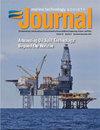PACE: NASA的一项任务如何与联合国海洋科学促进可持续发展十年保持一致(OceanShot #1)
IF 0.7
4区 工程技术
Q4 ENGINEERING, OCEAN
引用次数: 1
摘要
浮游生物、气溶胶、云、海洋生态系统(PACE);https://pace.gsfc.nasa.gov)任务,计划于2024年1月发射,将扩展美国宇航局在20世纪90年代末开始的连续高质量海洋颜色,大气气溶胶和云数据记录,建立在海岸带彩色扫描仪(CZCS),海景宽视场传感器(SeaWiFS),中分辨率成像光谱仪(MODIS),PACE的全球高光谱成像辐射计设计概念将使地球海洋生物的新发现成为可能(图2),例如为海洋食物网提供燃料的生物多样性以及水生生态系统如何应对环境变化。它的仪器载荷(图3)还将观测地球大气层,研究云、空气中的气溶胶粒子以及两者之间的相互作用。把海洋、云层和气溶胶放在一起观察,将有助于我们更好地了解它们在地球进化过程中所扮演的角色。PACE科学数据记录的其他应用——从确定水生有害藻华的频率、程度和持续时间,到提高我们对空气质量的理解——将带来直接的经济、娱乐和社会效益。最终,通过扩展NASA长期以来的全球地球卫星观测记录,PACE任务将在未来十年以新的先进方式监测我们的家园。本文章由计算机程序翻译,如有差异,请以英文原文为准。
PACE: How One NASA Mission Aligns With the United Nations Decade of Ocean Science for Sustainable Development (OceanShot #1)
Abstract The Plankton, Aerosol, Cloud, ocean Ecosystem (PACE; https://pace.gsfc.nasa.gov) mission, scheduled for launch in January 2024, will extend the continuous high-quality ocean
color, atmospheric aerosol, and cloud data records begun by NASA in the late 1990s, building on the heritage of the Coastal Zone Color Scanner (CZCS), Sea-viewing Wide Field-of-view Sensor (SeaWiFS), Moderate Resolution Imaging Spectroradiometer (MODIS), and Visible Infrared Imaging Radiometer
Suite (VIIRS) (Figure 1). PACE's global hyperspectral imaging radiometer design concept will enable new discoveries in Earth's living ocean (Figure 2), such as the diversity of organisms fueling marine food webs and how aquatic ecosystems respond to environmental change. Its instrument payload
(Figure 3) will also observe Earth's atmosphere to study clouds, airborne aerosol particles, and the interactions between the two. Looking at the ocean, clouds, and aerosols together will improve our knowledge of the roles each plays in our evolving planet. Other applications of PACE science
data records—from identifying the frequency, extent, and duration of aquatic harmful algal blooms to improving our understanding of air quality—will result in direct economic, recreational, and societal benefits. Ultimately, by extending and expanding NASA's long record of global
Earth satellite observations, the PACE mission will monitor our home planet in new and advanced ways in the coming decade.
求助全文
通过发布文献求助,成功后即可免费获取论文全文。
去求助
来源期刊

Marine Technology Society Journal
工程技术-工程:大洋
CiteScore
1.70
自引率
0.00%
发文量
83
审稿时长
3 months
期刊介绍:
The Marine Technology Society Journal is the flagship publication of the Marine Technology Society. It publishes the highest caliber, peer-reviewed papers, six times a year, on subjects of interest to the society: marine technology, ocean science, marine policy, and education.
 求助内容:
求助内容: 应助结果提醒方式:
应助结果提醒方式:


